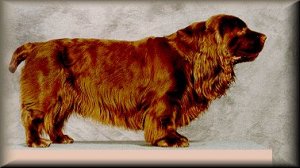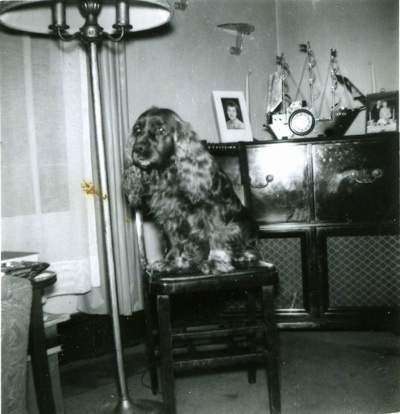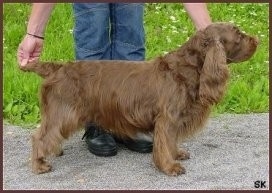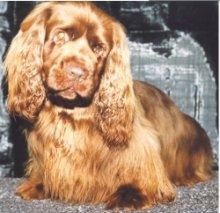
Berlottan Amadeus in Budapest, 1996, photo courtesy of Kennel Berlottan Field and Sussex Spaniels
SUH-siks SPAN-yuhl 
The Sussex Spaniel is a strong, massive dog with a long, low body that has a level topline. The skull is wide, broad and somewhat heavy, moderately long with a full stop. The muzzle is square in profile and is about 3 inches long (7.6 cm). The nose is liver colored. The large eyes are hazel in color. The large, low-set ears are long and hanging, covered with soft, wavy hair. The neck is slightly arched. The chest is deep and well developed. The legs are very short. The tail is customarily docked to 5-7 inches in length (12.5-17.5 cm.). Note: docking tails is illegal in most parts of Europe. The coat is either flat or slightly wavy. There is feathering on the neck, legs, tail and feet. The coat comes in a rich golden liver color.
With enough exercise the Sussex Spaniel is stable and calm inside the house. It is not very outgoing compared to other spaniels. It works very enthusiastically. On the hunt in the field it barks continuously, moving with a characteristic swinging gait. This breed adapts well to hunting and retrieving small game, especially in wooded areas. This dog sometimes bays when it is hunting. The Sussex Spaniel is the only Spaniel that does this. It is also a good companion dog. This breed loves everyone and is charming, gentle and loyal. These are very sociable dogs, which usually get along well with cats and are excellent with children. A well-socialized Sussex with a true pack leader will get along with other dogs. They tend to be less playful and demonstrative than other Spaniels, with a lower energy level. The Sussex Spaniel is a quick learner, but it is important to be consistent with them. They need firm leadership and patient training. This breed likes to bark. You should teach them, one bark, for instance when the doorbell rings, is sufficient. Owners need to make clear who runs the home, needing to be stronger minded, in a firm but calm way, than the dog or it can become snappish if annoyed, along with other behavior problems.
Height: 15 - 16 inches (38 - 40 cm)
Weight: 40 - 44 pounds (18 - 20 kg)
Prone to ear infections; the ears should be cleaned regularly. Some minor concerns are intervertebral disc syndrome, otitis exerna, heart murmur and enlarged heart. Gains weight easily, do not overfeed.
The Sussex Spaniel will do okay in an apartment if it is sufficiently exercised. It is moderately active indoors and a small yard will be sufficient. This breed can live outdoors in temperate climates as long as it has warm shelter, but it generally does better as a house dog that also has access to a yard.
The Sussex Spaniel needs to be exercised regularly by taking it on a daily walk, where the dog is made to heel beside or behind the human holding the lead, as in a dog's mind the leader leads the way and that leader needs to be the human. Not only does the dog need a walk to satisfy its natural migration instinct, but it will quickly put on weight if it gets too little exercise. It enjoys retrieving and swimming and being outdoors in the woods and fields, but bear in mind it has a tendency to follow its nose. This breed may howl if not properly exercised and left alone.
About 12-15 years
About 5-10 puppies
The soft, medium-length, golden-red coat of the Sussex Spaniel should be brushed and combed regularly. Keep the ears clean and trim excessive hair between the pads on the bottom of the feet, but leave the tuft growing between the toes on the upper part of the feet. If necessary, have the older and lighter hair removed by plucking. Too much hair beneath the ears should be trimmed at regular intervals. The teeth should be checked in a puppy when new teeth emerge to make sure they do not push existing teeth aside, resulting in crooked teeth. This breed is an average shedder.
The Sussex Spaniel is a fairly rare breed. It was developed in the 1800s in Sussex, England. It is a small-game hunter and companion dog. The breed was probably developed from crosses of spaniels with hounds. The dogs were used as field hunting dogs. Their slow pace along with their fine nose, good strength and stamina made them popular for hunters on foot flushing and retrieving upland game. The breed’s numbers plummeted during World War II. An English breeder by the name of Joy Freer is credited for saving the breed. Joy owned eight of these dogs which she saved and fed during the war. Most of today's Sussex Spaniels are direct descendants from her dogs. The Sussex Spaniel was recognized by the AKC in 1884. It was one of the original nine breeds recognized by the AKC. Some of the Sussex Spaniel's talents include: tracking, hunting, retrieving and watchdog. It is the only spaniel to bay while hunting.
Gun Dog, AKC Sporting Group

"Rusty, my Sussex Spaniel was born about 1948. This picture was taken about 1952 in Ashland, Oregon, by Mary Oliver Conner."

World Winner 2000 and 2002, etc. Berlottan Amanda, female at 11 years old, photo by Sanna Korpela FIN

Meet Happy Go Lucky (Lucky), photo courtesy of Sussex Spaniel Club of America, Inc.
Tootsie at 2 years old
Tootsie at 5 years old
Oliver the Sussex Spaniel at 5 years old